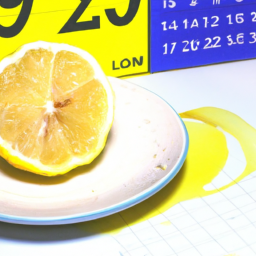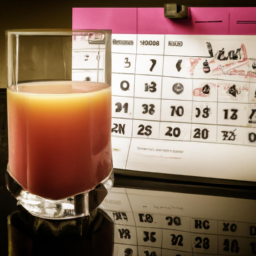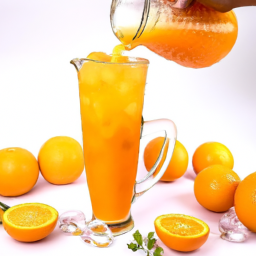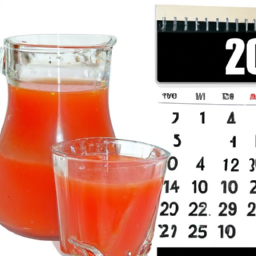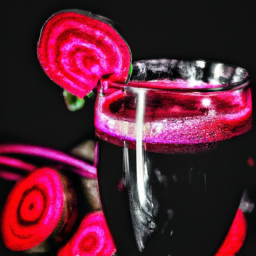As a lemon juice enthusiast, it’s difficult to imagine my daily routine without this tangy and refreshing ingredient. Lemon juice adds a burst of flavor to everything, from salad dressings to marinades. However, a common question that frequently crosses my mind is, ‘How long does lemon juice last?’
It’s a common concern, especially when you want to make sure you’re using fresh and safe ingredients in your meals. But let me tell you, I’ve had my fair share of experiences with expired lemon juice. It’s not a pretty sight, and the consequences can be severe.
That’s why understanding the shelf life of lemon juice is crucial for any home cook or chef. In this article, I’ll dive deep into the factors that affect lemon juice’s shelf life, how long it lasts, and the signs to look out for when it goes bad. So, let’s get started and make sure we’re all using fresh, safe, and delicious lemon juice in our recipes.
Key Takeaways
- Freezing is the most effective preservation method for lemon juice, while bottled juice should be refrigerated.
- Proper storage of lemon juice includes an airtight container in the coldest part of the fridge, away from heat and light, and strong-smelling foods.
- The shelf life of opened lemon juice in the fridge is 2-3 days, but freezing in ice cube trays or adding salt/vinegar can extend it.
- Using expired lemon juice can lead to food poisoning and illness due to the growth of bacteria such as E. coli, Salmonella, Listeria, and Botulism, so it’s important to throw it out when in doubt.
Factors Affecting Lemon Juice Shelf Life
So, how long can you keep your precious lemon juice? Well, it all depends on a few factors that affect its shelf life.
One of the most important factors is the preservation method used. Lemon juice can be preserved by freezing, bottling, or canning. Freezing lemon juice is the most effective way to extend its shelf life. However, if you choose to store it in a bottle, you should keep it in the refrigerator to slow down the growth of bacteria. If you want to can your lemon juice, you must use a pressure canner to prevent the growth of harmful microorganisms.
Another factor that affects the shelf life of lemon juice is the storage technique used. The best way to store lemon juice is in an airtight container in the refrigerator. Exposure to heat and light can cause the juice to spoil quickly. Also, avoid storing the juice near foods with strong odors as it can cause the juice to absorb the flavors of other foods.
By following these preservation and storage techniques, you can extend the shelf life of your lemon juice and enjoy its refreshing taste for longer.
Now, let’s move on to the next section and find out how long lemon juice can last.
How Long Does Lemon Juice Last?
You might be surprised to learn that the shelf life of this citrusy liquid is shorter than you think. Lemon juice can last for around 2-3 days when stored in the refrigerator after opening. However, this time frame can be extended by preserving the juice in a few different ways. One way is to freeze the juice in an ice cube tray and then transfer the frozen cubes to a freezer-safe container. This can prolong the shelf life of lemon juice for up to 4-6 months. Another method is to add a small amount of salt or vinegar to the juice before storing it in the refrigerator. The acidity in these ingredients helps to slow down the oxidation process and extend the life of the juice.
Lemon juice not only adds a tangy flavor to food and drinks, but it also comes with a range of benefits for the skin. Its high vitamin C content helps to brighten and even out skin tone, while its natural acids can help to exfoliate and unclog pores. However, to fully reap the benefits of lemon juice for the skin, it is important to use fresh lemon juice that has not gone bad. In the next section, we will discuss the signs that lemon juice has gone bad and how to tell if it is still safe to use.
Signs that Lemon Juice has Gone Bad
If left unrefrigerated, lemon juice can spoil quickly due to its high acidity level, which creates an ideal environment for bacteria to grow. Up to 25% of opened bottles can go bad within a week. The best way to prevent spoilage is to store lemon juice in an airtight container in the refrigerator, which slows down bacterial growth and keeps the juice fresh for a longer period.
It’s important to use lemon juice before it spoils, but if you have leftovers, there are alternative ways to use it. Lemon juice can be a natural cleaner for your home, breaking down dirt and grime, and a natural preservative for fruits and vegetables, preventing them from browning too quickly. With these alternative uses, you won’t have to worry about wasting any leftover lemon juice.
To store lemon juice properly, make sure to keep it in an airtight container in the refrigerator. This will help to slow down bacterial growth and keep the juice fresh for longer.
Tips on How to Store Lemon Juice
To keep your lemon juice fresh and flavorful, it’s essential to store it properly in the refrigerator. You can store it in a variety of containers, such as glass jars, plastic containers, or plastic bags. However, it’s important to choose containers that are airtight and have a good seal to prevent air from getting in and oxidizing the lemon juice.
Another important factor in preserving freshness is to store the lemon juice in the coldest part of your refrigerator. This means storing it in the back of the fridge, where the temperature is most consistent and the air is less likely to circulate.
Additionally, to extend the life of your lemon juice, consider adding a little bit of sugar or salt to the juice before storing it. This can help prevent bacterial growth and keep the lemon juice fresh for longer.
Now, let’s move on to the next section about freezing lemon juice.
Freezing Lemon Juice
When freezing lemon juice, make sure to use airtight containers that are freezer-safe to prevent freezer burn. This is important in maintaining the flavor and freshness of the juice.
You can also freeze lemon juice in ice cube trays and transfer them to airtight containers once they’re frozen.
Frozen lemon juice can last up to 4-6 months in the freezer. Aside from preserving the freshness of lemon juice, freezing it also offers many benefits.
Frozen lemon juice can be used in a variety of recipes such as marinades, dressings, and sauces. It can also be used to add a burst of flavor to drinks and cocktails.
With the convenience of having frozen lemon juice on hand, you can easily add a touch of lemon to any dish or drink whenever you want.
Now, let’s move on to the next section about using expired lemon juice.
Using Expired Lemon Juice
Expired lemon juice may not be as effective in recipes and can potentially spoil the taste of your dishes. As lemon juice ages, it loses its acidity and can become bitter. If you’re unsure whether or not your lemon juice has expired, there are a few signs to look out for:
- The juice has a cloudy appearance.
- The flavor is dull or off.
- There is mold or other growth in the bottle.
If you notice any of these signs, it’s best to avoid using the expired lemon juice in your cooking or baking. Instead, consider using it for alternative purposes such as cleaning or as a natural beauty remedy.
Moving on to the next section about health risks of using expired lemon juice, it’s important to note that consuming expired lemon juice can potentially be harmful to your health.
Health Risks of Using Expired Lemon Juice
You may not realize it, but using expired lemon juice can pose potential health risks that you wouldn’t want to risk. The expiration date on a bottle of lemon juice is not just a suggestion, but rather a warning that the contents may no longer be safe for consumption. In fact, expired lemon juice can contain harmful bacteria that can cause food poisoning or other serious illnesses.
To understand the potential health risks of using expired lemon juice, take a look at the table below. It shows the types of bacteria that can grow in expired lemon juice and the symptoms they can cause. As you can see, the risks range from mild stomach upset to severe illness, depending on the type of bacteria present.
| Bacteria | Symptoms |
|---|---|
| E. coli | Stomach cramps, diarrhea, vomiting |
| Salmonella | Abdominal pain, fever, diarrhea |
| Listeria | Fever, muscle aches, diarrhea |
| Botulism | Muscle weakness, double vision, difficulty breathing |
It’s important to note that these health risks apply not only to expired lemon juice, but also to any expired food or beverage. So, if you’re unsure about the freshness of your lemon juice, it’s better to err on the side of caution and toss it out. Now, let’s move on to some delicious recipes that use fresh lemon juice.
Recipes Using Lemon Juice
Now that we’ve discussed the health risks of using expired lemon juice, let’s move on to the fun part – recipes! Lemon juice is a versatile ingredient that can be used in a variety of dishes, from marinades to cocktails.
When making a marinade, lemon juice adds a bright and tangy flavor that helps to tenderize the meat. It also works well in salad dressings and as a garnish for seafood dishes.
In addition to savory dishes, lemon juice can also be used in sweet recipes. It’s a key ingredient in lemon bars and lemon meringue pie. Lemon juice can also be used to make refreshing cocktails like lemon drop martinis and whiskey sours. If you’re feeling adventurous, try using lemon juice in a homemade lemonade or sorbet.
The possibilities are endless when it comes to incorporating lemon juice into your cooking and baking. As we’ve seen, lemon juice is a versatile ingredient that can be used in many different ways.
In the next section, we’ll explore other uses for lemon juice that you may not have thought of.
Other Uses for Lemon Juice
I’m excited to share with you some of my favorite uses for lemon juice beyond cooking. Lemon juice is an incredibly versatile ingredient that can be used for cleaning and household applications, personal care, and beauty.
When it comes to cleaning, lemon juice can be used to remove stains, brighten up surfaces, and even freshen up the air.
In terms of personal care and beauty, lemon juice can be used to improve the appearance of hair and skin, whiten teeth, and even soothe sore throats.
Cleaning and Household Applications
Lemon juice can be used as a natural cleaner for surfaces such as countertops and cutting boards due to its acidic properties. Here are some cleaning hacks using lemon juice as a natural disinfectant:
-
Mix lemon juice and baking soda to create a paste for scrubbing stubborn stains on surfaces.
-
Soak a sponge in lemon juice and use it to clean the inside of microwaves or stovetops.
-
Dilute lemon juice with water and spray it on shower walls to remove soap scum and hard water stains.
-
Mix lemon juice with vinegar and use it to clean and disinfect wooden cutting boards.
Using lemon juice as a natural cleaner not only saves money, but it’s also safer for the environment and your health.
Now, let’s move on to the next section about personal care and beauty.
Personal Care and Beauty
Get ready to transform your beauty routine with these mind-blowing natural hacks using a common household ingredient – lemon juice! Not only is lemon juice a staple in cooking, but it also has many benefits when it comes to personal care and beauty.
One of the easiest ways to incorporate lemon juice into your beauty routine is by making your own DIY lemon skincare products. By mixing lemon juice with other natural ingredients like honey, sugar, and coconut oil, you can create a variety of skincare products such as face masks, body scrubs, and even toners.
Lemon juice contains vitamin C and citric acid, which helps brighten and even out skin tone while also reducing the appearance of fine lines and wrinkles. Additionally, lemon essential oils can be added to your favorite moisturizer or shampoo for an added boost of nourishment and shine.
So why not try incorporating lemon juice into your beauty routine for a natural and effective way to care for your skin and hair? Lemon juice has many benefits when it comes to personal care and beauty. It can be used to create a variety of DIY skincare products that are both natural and effective. Lemon essential oils can also be added to your favorite beauty products for an added boost of nourishment.
So next time you’re in the kitchen, don’t forget to grab a lemon and try out some of these amazing beauty hacks!
Frequently Asked Questions
Can I use bottled lemon juice instead of freshly squeezed lemon juice for cooking?
I prefer using freshly squeezed lemon juice over bottled for cooking due to its superior taste and natural benefits. Bottled juice may contain preservatives and lack flavor, but can be used for certain cooking techniques. Flavored varieties are available.
Does the acidity level of lemon juice affect its shelf life?
Lemon juice with higher acidity levels can last longer than those with lower levels. Preserving techniques such as refrigeration and proper storage can also extend its shelf life. Tracking expiration dates is crucial for safety.
How can I tell if my store-bought lemon juice is already expired?
To determine if store-bought lemon juice has expired, check the expiration date printed on the packaging. Proper storage, such as refrigeration, can extend the shelf life. Signs of spoilage include a sour smell, cloudiness, or mold.
Can I use lemon juice as a natural cleaning agent?
Lemon juice is a great natural cleaning agent due to its acidic properties. Mix it with water and use it to clean surfaces, floors, and even windows. Enjoy the refreshing lemon scent while cleaning. Some cleaning tips include using it to remove stains and grease.
Is it safe to use lemon juice on my skin for skincare purposes?
Using lemon juice on skin can offer benefits such as reducing acne and brightening complexion. Precautions include avoiding sun exposure and testing for sensitivity. Lemon juice should not be used as a substitute for sunscreen.
Conclusion
In conclusion, understanding the shelf life of lemon juice is crucial for its optimal usage. Like a ticking time bomb, lemon juice has a limited lifespan, and it’s essential to use it within its expiration date.
When stored properly, lemon juice can last up to a week in the refrigerator. However, once it’s past its prime, it can no longer provide the zesty and refreshing taste we love in our dishes. Using expired lemon juice is like playing a game of Russian roulette. It’s risky and can lead to health complications.
Therefore, it’s crucial to discard any lemon juice that has passed its expiration date. Lemon juice is a versatile ingredient that can be used for culinary purposes, but it also has other practical uses, such as cleaning and disinfecting surfaces.
So, don’t let your lemon juice go to waste, use it while it’s still fresh, and enjoy the tangy flavor it adds to your dishes.
Ilana has been a vegan for over 10 years. She originally made the switch for health reasons, but soon found herself becoming more and more passionate about the ethical and environmental implications of a vegan lifestyle. Ilana is the author of The Graceful Kitchen, a blog all about veganism. She loves to cook up delicious and nutritious vegan meals, and share her recipes with others who are interested in leading a cruelty-free life. Ilana is also a strong advocate for using whole foods as the foundation of a healthy diet, and believes that going vegan is one of the best ways to achieve this.
